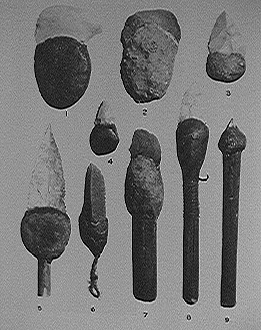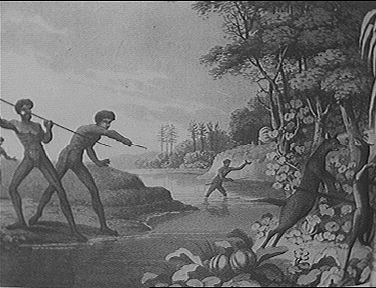


| 3 spears | location unknown |  |
Although I have classed these implements as spears, they are actually made up of stone primary points, with flaking and secondary retouch on the edges. These primary points have then been wrapped in paper-bark in order to protect them, then they have been hafted to worked wooden sticks, then painted with ochres and resins.
These three spears in the collection are approximately half a meter long, but the primary points range from approximately 5cms to 12cms (the point on the middle spear). Spears do not necessarily have to have primary points hafted to a wooden implement, they can also have blade attachment. The image below shows a variety of hafted implements.

The spears in the collection appear to be the type used in ceremonies and rituals such as circumcision, and scar incisions that required an extremely sharp blade that had ritual significance. Spears were also ceremonially exchanged over wide distances across Australia.
Spears also played a large part in hunting especially for fast moving animals such as kangaroos and fish. However, the spears used for hunting often had barbed spears, or more refined points, such as bondi points and other microliths.

"Hunting the Kangaroo", John Heaviside, 1813
(Parbury, 1988: p36)
The spears that exist in collections are often contemporary examples of what is believed to have been used in prehistoric times. The reason for this is that Australia's climatic conditions do not always favour the special conditions (constantly wet or dry) needed to preserve organic substances such as wood, fur and cloth. Therefore many stone artefacts dating to prehistoric times may have been hafted to wood which has subsequently disintegrated over time.





